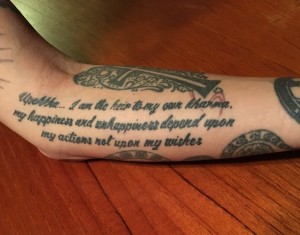Informant (J.H.), my mother, is a 50 year old Buddhist meditation teacher from Los Angeles. J.H. identifies as biracial, with both African and Southern European heritage. I interviewed her after stopping by for dinner one Monday evening. J.H. had a traditional roman Catholic upbringing, and has been studying meditation for 15 years. J.H. shared one of her favorite Buddhist stories, which explains the origin of a meditative chant that she teaches. Our story takes place during the Buddha’s lifetime.
J.H.: “There were 500 monks and nuns, who were sent into the forest to meditate for the rains retreats, which lasted for three months in the winter. Within days, they came running back to the Buddha saying that evil visions and sounds and smells were haunting them and they were too scared to stay in the forest, but the Buddha sent them back. Again, they came running back to him, terrified. Little did they know, that the tree spirits in that forest didn’t want them there, so they were doing anything they could to scare them off. So the Buddha sent them back a third time, but this time he sent them back with messages of love for the forest deities. These messages were; may you be happy, may you be at peace, may you be safe, may you be free. So when these monks went back into the forest, spreading love to these deities, it melted their hearts and they welcomed them. This is called ‘Metta,’ and one would use this when dealing with their own internal fear, or pain, or sadness, or when wanting to send compassion or care to others’ fear, pain or sadness, or suffering. We still use the ‘Metta practice.’ It is a traditional Buddhist practice for emanating kindness and care.”
While J.H.’s story stands on its own, Metta, or lovingkindness, is also a central part of the Buddhist tradition. Such stories in Buddhism are common, and often walk the line between myth and legend. While they are myths to Agnostic-Buddhists such as J.H., who teaches them strictly as metaphors for a greater lesson, these stories can be considered legends by the more traditional Buddhists who do not question their literal truth. Further, this particular Buddhist folk story does not leave the timeline of human existence like most religious mythologies, as from my experience Buddhism traditionally discusses life on earth rather than any divine being or beings. Metta is a very popular form of Buddhist meditation, always using some variation of the quote the monks told the tree spirits in J.H.’s performance.

